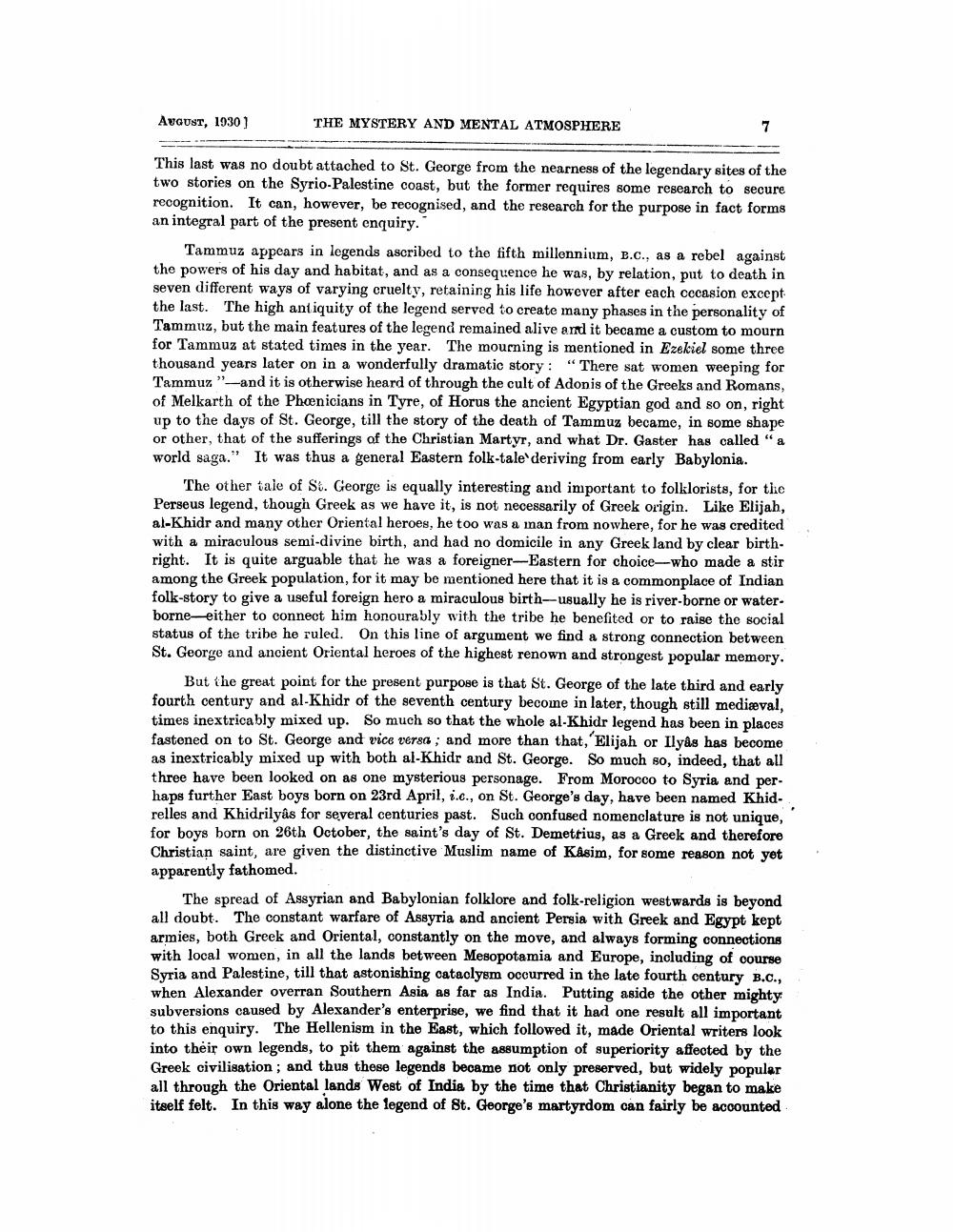________________
Avgust, 1930)
THE MYSTERY AND MENTAL ATMOSPHERE
This last was no doubt attached to St. George from the nearness of the legendary sites of the two stories on the Syrio-Palestine coast, but the former requires some research to secure recognition. It can, however, be recognised, and the research for the purpose in fact forms an integral part of the present enquiry.
Tammuz appears in legends ascribed to the fifth millennium, B.C., as a rebel against the powers of his day and habitat, and as a consequence he was, by relation, put to death in seven different ways of varying cruelty, retaining his life however after each cocasion except the last. The high antiquity of the legend served to create many phases in the personality of Tammuz, but the main features of the legend remained alive and it became a custom to mourn for Tammuz at stated times in the year. The mourning is mentioned in Ezekiel some three thousand years later on in a wonderfully dramatic story: "There sat women weeping for Tammuz"--and it is otherwise heard of through the cult of Adonis of the Greeks and Romans, of Melkarth of the Phoenicians in Tyre, of Horus the ancient Egyptian god and so on, right up to the days of St. George, till the story of the death of Tammuz became, in some shape or other, that of the sufferings of the Christian Martyr, and what Dr. Gaster has called "a world saga." It was thus a general Eastern folk-tale deriving from early Babylonia.
The other tale of St. George is equally interesting and important to folklorists, for tile Perseus legend, though Greek as we have it, is not necessarily of Greek origin. Like Elijah, al-Khidr and many other Oriental heroes, he too was a man from nowhere, for he was credited with a miraculous semi-divine birth, and had no domicile in any Greek land by clear birth. right. It is quite arguable that he was a foreigner-Eastern for choice—who made a stir among the Greek population, for it may be mentioned here that it is a commonplace of Indian folk-story to give a useful foreign hero a miraculous birth--usually he is river-borne or waterborne-either to connect him honourably with the tribe he benefited or to raise the social status of the tribe he ruled. On this line of argument we find a strong connection between St. George and ancient Oriental heroes of the highest renown and strongest popular memory.
But the great point for the present purpose is that St. George of the late third and early fourth century and al-Khidr of the seventh century become in later, though still medieval, times inextricably mixed up. So much so that the whole al-Khidr legend has been in places fastened on to St. George and vice versa ; and more than that, Elijah or Ilyas has become as inextricably mixed up with both al-Khidr and St. George. So much so, indeed, that all three have been looked on as one mysterious personage. From Morocco to Syria and perhaps further East boys born on 23rd April, i.e., on St. George's day, have been named Khid. relles and Khidrilyas for several centuries past. Such confused nomenclature is not unique, for boys born on 26th October, the saint's day of St. Demetrius, as a Greek and therefore Christian saint, are given the distinctive Muslim name of Kasim, for some reason not yet apparently fathomed.
The spread of Assyrian and Babylonian folklore and folk-religion westwards is beyond all doubt. The constant warfare of Assyria and ancient Persia with Greek and Egypt kept armies, both Greek and Oriental, constantly on the move, and always forming connections with local women, in all the lands between Mesopotamia and Europe, including of course Syria and Palestine, till that astonishing cataclysm occurred in the late fourth century B.C., when Alexander overran Southern Asia as far as India. Putting aside the other mighty subversions caused by Alexander's enterprise, we find that it had one result all important to this enquiry. The Hellenism in the East, which followed it, made Oriental writers look into their own legends, to pit them against the assumption of superiority affected by the Greek civilisation, and thus these legends became not only preserved, but widely popular all through the Oriental lands West of India by the time that Christianity began to make itself felt. In this way alone the legend of St. George's martyrdom can fairly be accounted




